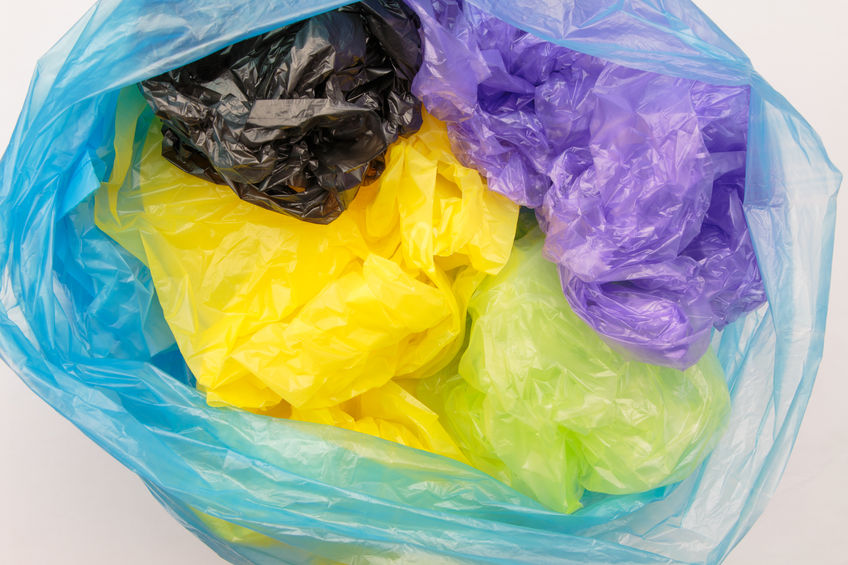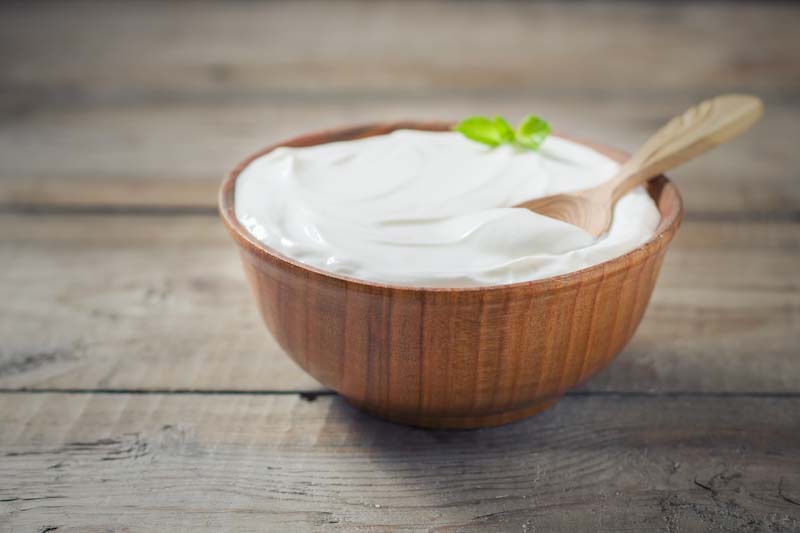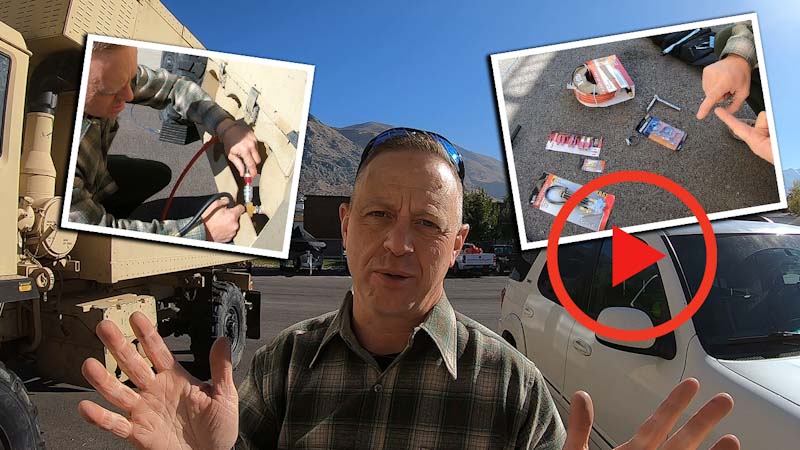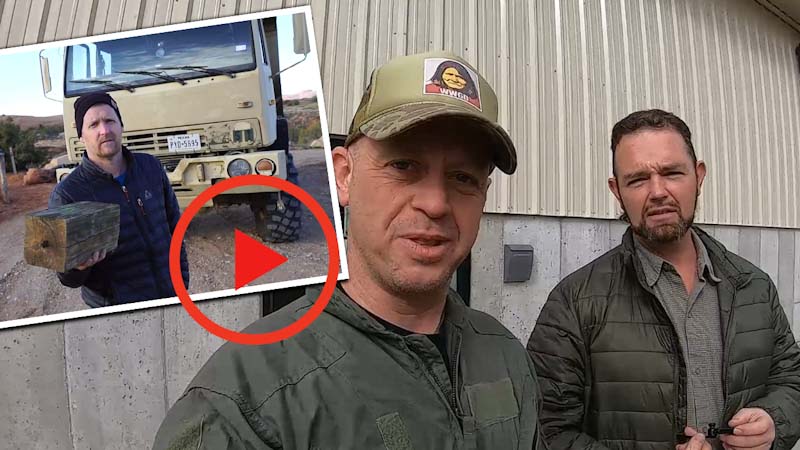Do you already reuse plastic shopping bags as trash liners? If you don’t use them for much else, than chances are you have hundreds of these bags laying around and relatively few ideas about how to use them for prepping.
As with many other forms of packaging that we “throw away” in our society, plastic bags have many purposes that make them very useful in an emergency.
When caught in a riot, a major natural disaster, or some other scenario, plastic bags can make surviving a bit easier. Instead of throwing all those bags away, or trying to give them away to friends and neighbors, start using plastic shopping bags in other ways.
Tools/Materials to Have On Hand
- Scissors
- Source of Heat – a steady, controllable source of heat can be used to shrink the plastic or make it easier to form fit over just about any surface. Hairdryers set on high, candles, and irons each have a purpose when reusing plastic bags. Ideally, you should have at least one of each onhand.
- Needle and Thread – use primarily if you decide to build up plastic bags into thicker layers, or you don’t have glue or duct tape onhand. A needle and thread are also some of the most versatile multi-purpose tools you can find.
- Duct Tape
- Crazy Glue – some glues that adhere to plastic may not work with plastic shopping bags. Be sure to test the glue out before using it in a project.
- Permanent Marker
- Ruler
How to Reuse Plastic Bags
Rope
Even though you may know that rope is a staple survival tool, there may be times when you don’t have enough on hand. If you do not have access to vines or plants with suitable fibers, you can make rope from plastic bags. Aside from being durable, plastic bag rope is also waterproof.
When making plastic bag rope, make sure that you know how to join the bags together, and also how to braid for the maximum amount of strength. As with other kinds of rope, remember that it friction will cause it to wear each time you use it. These ropes can also break unexpectedly because the plastic itself will wear and become weaker with each usage.
Braided Mats for Shelters
There are at least four ways to bake braided mats from plastic bags that can be turned into shelters.
- Take plastic bags and weave them into a flat surface much as you would a wide friendship bracelet
- Braid the plastic bags into rope, and then glue, tape, or use heat to hold the rope in a mat form.
- Use basic weaving techniques to create a mat. For added strength, you can also braid the plastic bags into rope, and the weave with the ropes.
Video first seen on Thomas Dambo.
- Use a crochet hook or knitting needles much as you would for regular yarn. You will need fairly thick knitting needles, or a crochet hook with a large enough hook on the end. Bone, wood, and other natural materials can be used for these tools,or you can try to buy jumbo sized tools at a craft store.
Video first seen on David Jones.
Waterproofing Important Items
Have you ever had to carry paperwork around, only to find yourself in the middle of a rainstorm? Chances are, you used a plastic bag to cover your papers and prevent them from being ruined. Plastic bags can be used as all kinds of liners from trash pails, to drawers, to just about any other place where you need to keep moisture out or prevent it from escaping.
When heat is applied to plastic bags, it will soften the plastic and also cause some shrinkage. Consider a situation where you make a wooden rack, but do not have polyurethane or other sealants to protect the wood from moisture. As long as the wood will not be near a source of heat, you can use plastic bags to make a watertight sealant. Just lay the bags flat over the surface of the wood and use a hair dryer to melt the plastic.
If you do not have airtight and water tight containers for emergency supplies, you can also use this method to seal them in. Even though the plastic wrapping will be ruined when you open the supplies, it will still prevent moisture related damage before the items are opened.
To get the most out of using plastic bags this way, try to seal items in such a way that you only seal up enough in each packet for one time use.
Body and Building Insulation
It takes very little in the way of effort to use plastic bags for insulation. If you are stuck in a blizzard or freezing weather, you can just ball up the bags and place them between your body and an outer jacket. Plastic bags also work well a shoe liners if the shoes have holes in the soles or you are in especially cold weather. In the latter scenario, do not forget to let your feet breathe from time to time in order to get rid of the moisture buildup.
You can also insulate tents, building walls, and other shelters with plastic bags. When using plastic bags for insulation, always remember to allow adequate ventilation. Moisture can build up faster than you realize because the plastic will cut off all airflow.
Condensation from all that water can easily rot wood or collect in other places where it can cause all kinds of problems. For example, if you decide to insulate the walls of your house with plastic bags, they will do a fine job of reducing the effects of hot and cold temperatures. On the other hand, as condensation builds up in the walls, it can easily build up on electric cables and cause them to corrode.
Make Plastic “Fabric”
There are bound to be many times and places in the pre and post crisis world where you will find plastic “fabric” very useful. While plastic bags can make a good temporary covering, plastic fabric can go much further because the the layers create a thicker material that will be more durable. In addition, when you make plastic “fabric” you will no longer be limited by the size of an individual bag.
Here are a few things you can do with plastic fabric:
- If you build up enough layers, you will have a material thick enough to use in the formation of a frame for a gas mask. Even though most people use plastic bottles, you can still use bags and create a perfect fitting mask. Custom masks can make it easier to use DIY masks with different cartridge types, and also make it much easier to create a custom fit for children or others that are difficult to get good quality gas masks for.
- Plastic fabric can be used for blankets and tents.
- If you are planning to start a new garden, use thicker plastic fabric to choke out weeds before turning the soil over.
- You can also use plastic fabric for making clothes, but bear in mind that moisture from sweat will build up and cause problems unless you account for ventilation.
Video first seen on Needlepointers.
Plastic Bricks
Many people that have homes now may suddenly find them burned to the ground or rendered unlivable for some other reason. At the same time, getting wood from other parts of the country, or preparing it for building a new home will either be impossible or take a lot of time.
If you have plenty of plastic bags around and some sand, you can melt the plastic and make durable bricks. These bricks can also be used to create all kinds of platforms, walkways, or other structures.
Video first seen on New China TV.
Plastic can also be melted down and poured into molds for many other purposes. Basically, you would cast with plastic in much the same way that you would cast metal. For example, you can create a wax model for the object you wish to make, and then place it in wet sand. Next, simply pour the hot plastic into the sand.
As the wax melts and burns off, the plastic will fill in the cavity left behind. The wet sand will keep the form left by the model until the plastic dries. You can also use plaster molds for more intricate pieces.
Packing Material
From mason jars to eggs, plastic bags make excellent packing material. You can use them to absorb shock and also use them to prevent objects from rattling around in a box.
Aside from simply crumpling up plastic bags for packing material, you can also cut off the handles, blow some air into them, and then use duct tape to seal the bag so no air will escape. This is an ideal way to take up a good bit of space and still get the most protection from the bags.
Greenhouses
You can make a greenhouse of just about any shape or size using plastic bags. The simplest way to use plastic bags for this purpose is to start off by making plastic fabric. Once you have enough fabric on hand, create a frame and then affix the fabric to the frame. Do not forget to leave areas of clear plastic so that plenty of light gets into to the greenhouse.
Smaller, table sized “greenhouses” are also ideal for indoor settings where you need to provide extra humidity for specific plant types. Unlike glass or plastic bottle greenhouses, you can make the greenhouse as large as you need and house multiple plants together.
If you are planting in the early spring, late fall, or started other crops too late, plastic bags can also be used as temporary covers to prevent frost from getting onto the plants.
Bag Planters
When you have to bug out, there is a chance that you may wind up leaving a good bit of your stockpile behind. In these instances, containers suitable for plants and seedlings can easily be left behind in favor of food stores or other supplies.
If you have even one plastic bag on hand, you can still plant in it and start a “bag garden”. No matter whether you are in the woods, or even an inner city apartment building, just get some soil, put it in the bag, plant the seeds, and water as needed.
It should be noted that some plants will respond better to bag planters than others. In particular, plants that require good drainage may not do as well because water will tend to build up in the bag and drown the roots. If you have the bag planters in an outdoor setting, then go ahead and poke holes in the bottom of the bag to allow for good drainage. This can eliminate the need to turn over soil for a garden and cut back on the amount of time and effort required for pulling weeds and tending to other gardening matters.
Water Gathering Aide
No matter where you are or what is going on, plastic bags can be used to gather water. The easiest method entails simply digging a hole in the soil and putting a cup or other vessel in the hole. Place the plastic bag over the hole and put a rock or some other heavy object in the center of the plastic so that the bag bows down in the center. This water gathering aide will collect condensation as the temperature of the soil changes and releases water particles.
To get more water during daylight hours, take green leaves (from edible plant or tree sources) and add them to the hole. As the leaves wither, they will also release water which will then be trapped by the plastic.
If you happen to be in a rainstorm, plastic bags can be used directly to capture water. You can also unfold plastic fabric and suspend it high enough off the ground so that you can fit a larger container under the center.
Similar to collecting condensation from the ground, make sure that the center of the plastic is caved in. Add a few holes near the very center so that water can drain into the container. In this instance, the plastic fabric will act as a funnel and gather up any water that hits the area covered by it.
The next time you become annoyed because you have so many plastic shopping bags laying around, think about how useful they are for prepping and long term survival goals.
Start from now to learn how to fashion these bags into different tools and materials and you will be one cheap, and very useful step closer to being ready to survive just about any crisis scenario.
This article has been written by Carmela Tyrell for Survivopedia.









Pingback:Reinventing The Wheel: How To Get Perfectly Round Shapes | Survivopedia | March 16, 2017
|